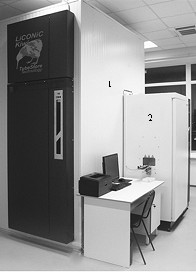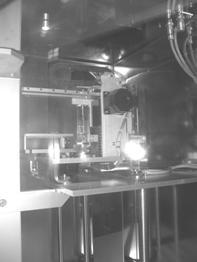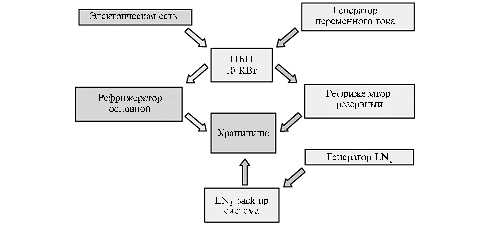doi: 10.15389/agrobiology.2012.3.32eng
УДК 631.46:57.083
AUTHORIZED LONG-TERM DEPOSITATION OF AGRICULTURAL MICROORGANISMS IN THE DEPARTMENTAL COLLECTION OF THE RUSSIAN ACADEMY OF AGRICULTURAL SCIENCES
V.I. Safronova, I.A. Tikhonovich
The joint Russian Collection of Agricultural Microorganisms (RCAM) was founded in 2010 at the All-Russia Research Institute for Agricultural Microbiology, Saint-Petersburg. For long-term maintenance and authorized depositing of microbial strains in RCAM the newest automated STC Tube Store at -80 °С (Liconic Instruments, Liechtenstein) is used. Liconic Instruments’ Tube Store becomes an extremely useful, simple and intuitive system for a long-term storage of microorganisms at optimum conditions without the loss of their valuable properties. This ultra low temperature store is based on the chest freezer principle. Samples are loaded into the chamber via special interface unit (-20 °С), which ensures a stable temperature and dry conditions into the storage compartment. Computer passwords used by depositors during the sample load operation ensure an authorized access to commercial strains of microorganisms. Unique «real time» online database of microorganisms has been organized on basis of the STC Tube Store Sample management software, which contains all information about the strains deposited: description, location in the store and movements of each sample. Such kind of store gives possibilities to intensify the search of new microbial cultures, keeping in mind the huge soil microbe’s biodiversity and a necessity to mobilize genetic resources of microorganisms for an agricultural production.
Keywords: microbial collections, long-term maintenance, authorized depositing of strains.
Improved yields of agricultural crops and product quality are relevant problems of plant growing in a view of ongoing global climate changes, soil degradation and reduce in areas of cultivated cropland. Biological technologies are an efficient and environmentally safe way to increase agricultural production. Agricultural biotechnology based on using microorganisms in crop and livestock production can provide a good contribution to solving global problems of human food supply and environment protection. In developed countries there are produced over 100 types of microbial inoculants for agriculture – entomopathogenic preparations, herbicides, fungicides, bacterial fertilizers, protein-vitamin concentrates, silage fodder yeast, etc. Biological means of plant protection, growth promoters of animals and plants, microbial fertilizers can reduce dosage of chemical pesticides and mineral fertilizers. This all results in better yields of high-quality agricultural products grown under reduced human impacts on croplands.
Valuable properties of microorganisms can be efficiently implemented in practice only upon the data from special microbial collections purposefully created for close investigation and long-term preservation of microbial resources maintaining their valuable properties. The latter task is problematic because a long-term storage of microbial strains in laboratory conditions is often associated with problems caused by genomic instability. The best modern technique for a long-term storage of microorganisms is cryopreservation (storage frozen at the temperature below - 60 °C). In cryopreserved microorganisms cellular metabolism is completely stopped, which ensures their genetic stability and preservation of practically valuable properties during a storage. Along with it, such deep cooling protects bacterial cells from a possible ice recrystallization thereby preserving their viability for decades (1-3). Owing to all these advantages cryopreservation was recommended for a wide use in Biological microbial resource centers (4). However, cryogenic equipment commonly used in many world microbial collections (Dewar vessels with liquid nitrogen, cryotanks and low-temperature freezers) has significant flaws and can’t provide neither a stable temperature nor safety of deposited culture. These technical imperfections significantly deteriorate the quality of cryopreserved biological material and allow unauthorized access to commercial strains.
In the Russian Federation, major works on maintaining and investigation of agricultural microorganisms are carried out in research institutes of the Russian Academy of Agricultural Sciences (RAAS) having a unique microbial collection (about 20 thousand cultures). In 2010, in order to maintain the microbial bank of RAAS and improve the efficiency of its use in agriculture, a Departmental collection of valuable agricultural microorganisms (VCSM – vedomstvennaya kollektsiya sel’skokhozyaistvennykh mikroorganizmov) was established in the All-Russia Research and Development Institute of agricultural microbiology.
 |
Fig.1. External view of storage and retrieval station for automated cryoconservation of biological samples (“Liconic Instruments”, Liechtenstein): 1 – storage unit, 2 – transfer unit.
|
The purpose of the presented work was introduction of an automatic robot-assisted storage and retrieval system for cryopreservation of tube samples of agricultural microorganisms with a built-in authorized access to commercially valuable samples, along with creation of real-time Internet database. The new storage and retrieval system Liconic STT-series with storage capacity of 200 thousand samples was purchased from Lyconic Instruments (Lichtenstein), installed in VCSM and set into operation in the year 2010. This advanced fully automated instrument was designed in focus of the newest world developments in robotic computer-aided cryogenic techniques.
The station includes two main units: the storage unit with freezing chamber maintaining the temperature of -80 °C and the transfer unit with the temperature of - 20 °C providing load and unload of the samples. This structure ensures stable temperature and minimum humidity in the storage unit. Samples of strains intended for freezing should be prepared according to a standard protocol for cryopreservation of microorganisms (5). Cells grown on an appropriate nutrient medium during an early stationary phase of growth should be suspended in a fresh medium of the same composition supplemented with cryoprotectant up to the cell titer of 108-1010/ml. Cryoprotectant - 10-15% glycerol, which easily penetrates through the cell membrane and stabilizes the hydrogen bonds of macromolecules thereby providing both intra- and extracellular antifreeze protection of the cells. After equilibration (15-60 min at room temperature), the suspension should be packaged in sterile tubes. The tubes are loaded into a freezing chamber with the use of special racks with tubes of 300 ul labeled by unique 2D-barcodes on the bottom. After the input of samples’ description into a computer database the barcodes are recognized by a special laser scanner and transformed into digital code. Then the racks with tubes are loaded into the depository via the transfer unit where the temperature is maintained at -20 C° and a robot TubePicker (Fig. 2) manipulates by the tubes, selects and unloads individual samples without unloading of an entire rack.
 |
Fig. 2. TubePicker robot manipulating by samples in a transfer unit of storage and retrieval station for automated cryoconservation of biological samples (“Liconic Instruments”, Liechtenstein).
|
Tube Store Sample management software operates by functioning of the storage and contains a complete database of samples: data of load-unload, location, operation log file, individual description, storage temperature log file.
The load of samples allows the built-in authorized access by a computer key password preventing from unauthorized withdrawal of deposited samples. The software provides rapid search of strains in a computer database by keyword: number of strain, genus or species of microorganism, useful property, host plant (for symbionts and pathogens), enterprise-depositor.
A unique online database of deposited samples was created using the program Tube Store Sample management, including complete information about the deposited strains and all activities performed on each sample in real time. The online database allows a remote monitoring of samples by depositors, as well as online search of strains by keyword available to a wide range of users. The depositor of strain and a customer interact through e-mail messages generated automatically at the order of strains, approval (or rejection) of an order, etc.
A B |
|
Fig. 3. Main (A) and backup (B) systems providing uninterrupted functioning of storage and retrieval station for automated cryoconservation of biological samples (“Liconic Instruments”, Liechtenstein). |
Smooth operation by the storage is performed by two types of systems - the main and back-up (Figure 3). During a normal regime, the freezing chamber is cooled by main refrigerator, which is powered from the grid through an uninterruptible power supply (UPS). Backup equipment includes diesel alternator, reserve refrigerator and a backup LN2 up system (liquid nitrogen), which injects liquid nitrogen when the temperature inside the freezing chamber increases. The tank with liquid nitrogen includes 250 liters and is replenished by liquid nitrogen generator. All backup equipment starts to work automatically if necessary.
Key features and resulting benefits of storage and retrieval station for automated cryoconservation of biological samples (“Liconic Instruments”, Liechtenstein) are presented below:
Stable temperature of storage, absence of its fluctuations |
|
Robot-assisted management system |
|
2D-barcode identification of racks and tubes |
|
Computer password (key) assigned at loading samples for storage |
|
Internet online database of samples |
|
Backup power supply and cooling systems |
|
Thus, the automatic cryopreservation system (“Liconic Instruments”, Liechtenstein) was found to be a unique instrument providing a long-term storage of microbial cultures in optimal conditions maintaining their valuable properties. The station operates as a biobank with ensured authorized access to practically valuable strains deposited by scientific and research institutes and commercial organizations involved in production of microbial agents.
REFERENCES
1. Farrant J., General Observations on Cell Preservation, in Low Temperature Preservation in Medicine and Biology, Ashwood-Smith M.J. and Farrant J., Eds., England, Kent: Pitman Medical Limited, 1980, pp. 1-18.
2. Safronova V.I., Osledkin Yu.S., Sviridova O.V. and Vorob’ev N.I., Metody kriokonservatsii kollektsionnykh kul’tur mikroorganizmov (Methods for Cryoconservation of Collection Cultures of Microorganisms), St. Petersburg, 2007.
3. Safronova V.I. and Novikova N.I., Comparison of Two Methods for Root Nodule Bacteria Preservation: Lyophilization and Liquid Nitrogen Freezing, J. Microb. Methods, 1996, vol. 24, pp. 231-237.
4. OECD Best Practice Guidelines for Biological Resource Centres, OESD, 2007.
5. NNI Cryopreservation Manual, USA, New York, Penfild: Nalge Nunc Int. Corp., 1998.
All-Russia Research and Development Institute of Agricultural Microbiology, RAAS, 196620 St. Petersburg-Pushkin, Russia
|
Received
|














